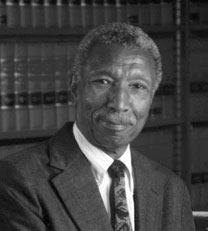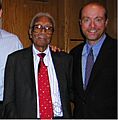Robert L. Carter facts for kids
Quick facts for kids
Robert L. Carter
|
|
|---|---|

United States District Judge Robert L. Carter
|
|
| Senior Judge of the United States District Court for the Southern District of New York | |
| In office December 31, 1986 – January 3, 2012 |
|
| Judge of the United States District Court for the Southern District of New York | |
| In office July 25, 1972 – December 31, 1986 |
|
| Appointed by | Richard Nixon |
| Preceded by | Thomas Francis Croake |
| Succeeded by | Kenneth Conboy |
| Personal details | |
| Born |
Robert Lee Carter
March 11, 1917 Caryville, Florida |
| Died | January 3, 2012 (aged 94) New York City, New York |
| Education | Lincoln University (A.B.) Howard University School of Law (LL.B.) Columbia Law School (LL.M.) |
Robert Lee Carter (born March 11, 1917 – died January 3, 2012) was an important American lawyer and a champion for civil rights. He worked hard to make sure everyone was treated fairly, no matter their race. Later, he became a federal judge in New York, where he continued to uphold justice.
Contents
Robert Carter's Early Life and Education
Robert Carter was born in Caryville, Florida, on March 11, 1917. When he was just six weeks old, his family moved to Newark, New Jersey. This move was part of the Great Migration, when many Black families moved from the Southern states to the North for better opportunities.
Growing Up in New Jersey
Robert's father passed away when he was only one year old. His mother, Annie Martin Carter, worked as a laundress to support the family. His older sister also helped by working as a seamstress.
Robert started high school in Newark. Later, his family moved to East Orange, New Jersey. It was there that Robert first stood up for what was right. He read that a court had ruled against schools that only let Black students use the swimming pool on certain days. Robert bravely entered the pool with white students, even though a teacher threatened him. The school decided to close the pool instead of letting all students swim together. Robert graduated from East Orange High School at age 16, having skipped two grades.
College and Law School
Robert was a very smart student. He earned a degree in political science from Lincoln University in 1937. He then went to Howard University School of Law, a historically Black university, and earned his law degree in 1940. Both of these degrees were earned with scholarships.
In 1941, he earned another law degree from Columbia Law School. For this degree, he wrote a special paper that later helped the NAACP (National Association for the Advancement of Colored People) in their fight for equal rights.
Serving in the Military
Before the United States entered World War II, Robert joined the United States Army Air Corps. During his time in the military, he faced unfair treatment because of his race. For example, a white captain told him that they didn't believe in educating Black people. These experiences made Robert even more determined to fight for equality.
Despite these challenges, Robert became an officer. He was the only Black officer at Harding Field in Baton Rouge, Louisiana. There, he bravely used the officers' club, which had been for white officers only, making it open to everyone.
Family Life
In 1946, Robert Carter married Gloria Spencer. They had two sons, John W. Carter and David Carter. John later became a judge in New York, following in his father's footsteps.
Robert Carter: A Champion for Civil Rights
After his military service, Robert Carter began working at the NAACP Legal Defense and Educational Fund (LDF) in 1944. The LDF was a legal organization that fought for the rights of Black Americans. He quickly became an important lawyer there.
Working with Thurgood Marshall
By 1948, Robert was a legal assistant to Thurgood Marshall, who would later become the first Black Supreme Court Justice. Together, they worked on many important cases that aimed to end segregation in schools. These cases included Sipuel v. Board of Regents of the University of Oklahoma (1948), Sweatt v. Painter (1950), and McLaurin v. Oklahoma State Regents (1950).
The Landmark Brown v. Board of Education Case
One of Robert Carter's most famous contributions was to the Brown v. Board of Education case. This case challenged segregation in public schools. Robert argued on behalf of Oliver Brown, one of the main people in the case.
He pushed for the court to consider research by psychologists Kenneth and Mamie Clark. Their studies showed how harmful segregated schools were to the learning and development of minority students. The U.S. Supreme Court used this research when they made their historic decision to end segregation in public schools. This ruling overturned the old "separate but equal" idea from Plessy v. Ferguson.
Leading the NAACP's Legal Efforts
In 1956, Robert Carter took over from Thurgood Marshall as the main lawyer for the NAACP. In this role, he argued and won more important cases before the Supreme Court.
- NAACP v. Alabama (1958): This case stopped Alabama from trying to get lists of NAACP members, which would have put them in danger.
- Gomillion v. Lightfoot (1960): This case found that Alabama had unfairly redrawn voting districts in Tuskegee to prevent Black citizens from voting. This violated the 15th Amendment.
- NAACP v. Button (1963): This case struck down a Virginia law that tried to limit how public interest lawyers could help people.
These victories helped to remove tools that some Southern states used to resist the desegregation ordered by Brown v. Board of Education. In total, Robert Carter argued 22 cases before the Supreme Court and won 21 of them!
Other Important Activities
Robert Carter was also a member of the Alpha Phi Alpha fraternity and helped start the National Conference of Black Lawyers. He was involved in many other groups and committees that worked to improve the legal system and education.
Leaving the NAACP
In 1968, Robert Carter and his legal team resigned from the NAACP. This happened after another lawyer, Lewis Steel, was fired for criticizing the Supreme Court. Robert believed the NAACP board fired Steel because they thought the legal department was taking on cases that were too controversial. After leaving, Robert worked at Columbia University and then joined a private law firm.
Robert Carter's Judicial Career
On July 25, 1972, President Richard Nixon appointed Robert Carter to be a judge for the United States District Court for the Southern District of New York. This was a very important position. He served as a judge until his death in 2012.
Key Cases as a Judge
As a judge, Robert Carter handled many different types of cases. He oversaw cases about the merger of the National Basketball Association (NBA) and the American Basketball Association (ABA). He also settled a lawsuit about basketball rules and presided over cases involving famous basketball players.
Judge Carter also handled important cases involving discrimination. He worked on cases where Black and Hispanic people were unfairly treated when applying to join the New York City police force.
Later Life and Lasting Impact
Robert Carter wrote many articles and essays about civil rights and discrimination in the United States. He often wrote about school segregation and his friends, like Thurgood Marshall.
In 2004, the NAACP honored Robert Carter with the Spingarn Medal, a very high award for outstanding achievement by an African American. That same year, Fordham University School of Law gave him an honorary law degree. In 2005, he published his memoir, A Matter of Law, which shared his experiences as a civil rights advocate.
Robert Carter passed away on January 3, 2012, at the age of 94. He left behind a powerful legacy as a lawyer and judge who fought tirelessly for justice and equality for all.
Images for kids


